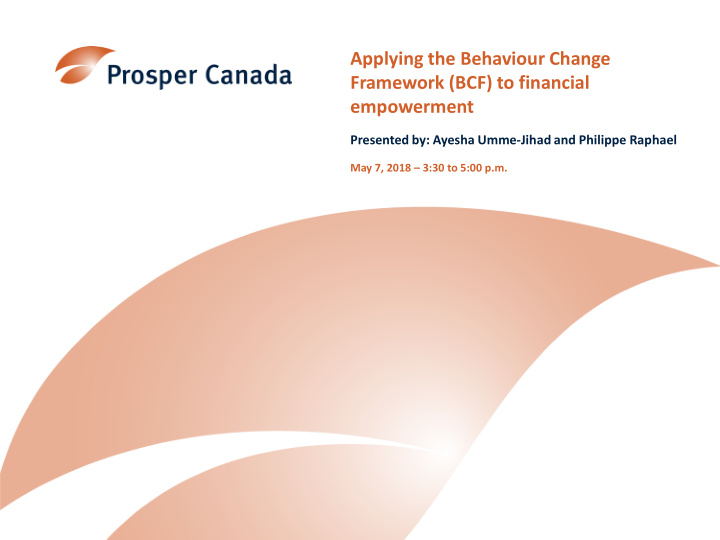



Applying the Behaviour Change Framework (BCF) to financial empowerment Presented by: Ayesha Umme-Jihad and Philippe Raphael May 7, 2018 – 3:30 to 5:00 p.m.
Today you will… Gain an understanding of the Behaviour Change Framework (BCF) Learn how to apply the BCF Think about incorporating the BCF into your work 2
Agenda for this session BE & the Case Intro design The BCF Reflection application process 3
Say hello to Kim! Kim J Toronto, Ontario Future $aving$ financial coaching participant Age: 36 Gender identity: Male Employment: 3 part-time jobs (produce delivery, barista, painting jobs) Career goal: Home painting business Money goal: Pay down debts; buy a car; save money for business start-up Current financial habits: Okay with saving money but can easily fall off track; doesn’t write down a budget; often thinks he has more money than he does * Completely fictional 4
What’s behaviour economics? People behave in “predictably irrational” ways, and there are recognizable patterns that govern their behaviour under certain circumstances. * Designing for Behaviour Change toolkit 5
Has this happened in your FE-related program? Clients didn’t make Clients didn’t act in the specific decision their best financial that program was interest made for Clients did not Clients’ reasons or change their motivations are not behaviour after that easy to predict gaining knowledge 6
The design process 7
The BCF 8
Questions? 9
Case application: Tax clinic time! 10
Case application: Tax clinic evaluation findings Missing documents: Many filers do not bring all their papers/forms to a tax clinic Leave when waiting too long: Filers may often leave when they feel like they’re waiting too long to meet with a volunteer filer Benefits skipping: Some benefits require an application form separate from tax filing that many clients do not pursue Make refund arrangements: Many filers have already decided what they are doing with their refund, which may not be the most financially beneficial decision Over-commute: Many filers are unsure of the closest tax clinic and travel to ones that their family members or friends have recommended which may cost them more 11
Case application: Instructions Make a group of 3-4 people at your table. 1 Get a pre-populated template. As a group, read sections 1, 2, and 3. Discuss (5 mins). 2 Fill out Section 4 – Resulting effects (10 mins). 3 Come up with as many effects as you can Fill out Section 5 – Program solutions (15 mins). 4 Come up with lots of ideas or be detailed with a few 12
Let’s hear from some of you Choose one group member to speak Read your responses for questions 3, 4, 5, and 9a or 9b 13
Reflections and questions 14
Insights: Is this useful for you? Write a note to yourself about one of the following: A situation in your Someone you work where you work with who could use this? could use this? What supports are needed to use the BCF? 15
Resources Bridgeable’s Designing for Behaviour Change Toolkit: http://toolkit.bridgeable.com/ • Design Thinking with IDEO: https://www.ideou.com/pages/design-thinking • IDEO’s projects related to Financial health: • https://www.ideo.org/programs/financial_health Insights to Impact: Harnessing behaviour science to build financial well-being, by Deloitte • and Prosper Canada Report: https://learninghub.prospercanada.org/knowledge/insights-to-impact-harnessing- – behavioural-science-to-build-financial-well-being/ Webinar: http://prospercanada.org/Resources/Webinars/Insights-to-impact-What- – behavioural-science-tells.aspx Contact us! Philippe Raphael, Research and Ayesha Umme-Jihad, Research and Evaluation Officer Evaluation Officer praphael@prospercanada.org aummejihad@prospercanada.org 416-665-2828 ext 2252 416-665-2828 ext 2247 16
Recommend
More recommend